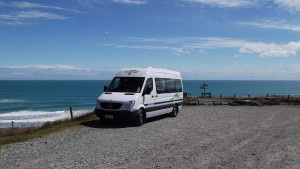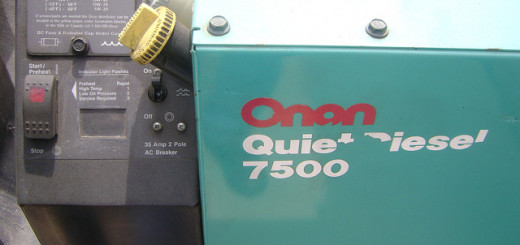While some of the largest motorhomes can prevent you from hitting certain scenic byways, or shut you out of smaller state and national parks, small motorhomes suffer from no such issues. These rigs are available in all shapes and sizes — from nimble van conversions to luxuriant diesel pushers — and there is literally something out there for everyone. Regardless of your specific needs and budget, there’s a small motorhome out there somewhere with your name on it.
In the hierarchy of recreational vehicles, the motorhome is undeniably at the top of the food chain. Some people prefer the proximity to nature you can enjoy from a tent, and others would rather tow their RV around, but there’s no arguing with the convenience and luxury you can get from a motorhome.
Benefits of Small Motorhomes
Though small motorhomes have less interior space than their larger counterparts, these rigs still have a lot to offer. From the extreme maneuverability of tiny class B motorhomes, to the sumptuous luxury of small diesel pushers, the benefits of buying a smaller rig are undeniable.
Some of the most important factors to consider include:
- better fuel economy
- easier to drive and park
- fit in a wider range of camping spots
- more affordable
- cheaper insurance
- etc
Choosing a Small Motorhome
The sheer number of small motorhomes out there can make the process of settling on just one seem pretty overwhelming, but it doesn’t have to be. In fact, choosing and buying a small motorhome and, and should, be an enjoyable experience. If you make a list of your must-haves and your sort-of-wants, you’ll be able to narrow down your viable choices and then go from there.
There are a number of important factors to consider when looking at small motorhomes. Some of the most vital features include:
- number of beds
- gas mileage
- amount of storage space
- interior space and ceiling height
- leveling jacks
- slides
- other accessories and amenities
Your needs in those areas will help define the best type of small motorhome for your situation. If you need a lot of sleeping space in a relatively small motorhome, for instance, you may end up leaning towards a class C. Since even small class C motorhomes include cabover bunks, they typically offer more sleeping space than similarly sized class A rigs.
On the other hand, a class B will work better if you’re more concerned about maneuverability, storage, and gas mileage. Due to their diminutive sizes, these small motorhomes can even be used as daily drivers. However, if you need a lot of storage space and ceiling height, you’ll want to skip over both class B and C rigs and go straight to a class A–or a small diesel pusher.
Class B Motorhomes
Class B motorhomes are the smallest of the small. While there are small motorhomes in every class range, class B rigs are small by definition. These agile RVs are typically built on small truck chassis, and some of them are technically van conversions. The Mercedes Sprinter is one platform that has become popular in recent years.
Since class B motorhomes aren’t that much larger than vans, these rigs are extremely easy to drive, park, and store. In fact, some people even use their class B motorhome as a daily driver. They are a big more ungainly than regular vans, and some of the larger ones even include slide-outs, leveling jacks, and other advanced features, but these rigs will typically still fit into a standard parking spot if you need to stop for groceries.
The other main benefit of class B motorhomes is fuel economy, which is also a consequence of how small and aerodynamic these rigs often are.
However, the small size of class B motorhomes also means that they’re less suitable for extended road trips. The larger ones can sleep six people in relatively cramped quarters, but you can expect to spend a lot of time outdoors during the day.
Class C Motorhomes
Class C motorhomes are built on truck chassis, and they have recognizable van or truck cabs. The other most notable feature seen on most of these rigs is the cabover bunk, which is the reason that class C motorhomes typically have more sleeping space than other similarly sized RVs. However, the cabover space can also be used for storage, converted into an entertainment center, or used for various other purposes.
While most class C motorhomes are relatively short, some of them push 40 feet in length, which is a lot of weight to put on a truck chassis. For the purposes of the Small Motorhome Buyer’s Guide, we consider class C rigs that are under 28 feet in length to be small motorhomes.
Small class C motorhomes offer more storage and sleeping space than class B rigs, but they are still relatively easy to maneuver, park, and store. And at 28 feet or less, they fit easily into most national and state parks.
Most small class C motorhomes come with features like air conditioning and generators either standard or as an option, and they can also be found with slide-outs, which increase the interior living space.
Small Class A Motorhomes
Class A motorhomes are typically thought of as behemoths of the road, but there are a lot of options out there for size-conscious buyers. For the purposes of the Small Motorhome Buyer’s Guide, any class A rig that measures 30 feet or less qualifies as a small motorhome. At that length, it’s still possible to pull one of these rigs through a double parking spot if you need to stop for groceries or other supplies, and they are surprisingly maneuverable.
While very few class A motorhomes offer forward bunks, these rigs have a lot of other things to recommend them. Since class A motorhomes are built on heavy duty chassis, they can hold and pull a lot more weight. And since class A rigs that qualify as small motorhomes are underweight in comparison to their peers, they’re often great at towing other vehicles.
The biggest selling points of class A motorhomes are:
- lots of interior living space
- extensive storage space
- bigger gas, water, and wastewater tanks
- taller ceiling heights
Those factors make small class A motorhomes uniquely suited to extended camping trips. And since these rigs can even be found in the 25 foot range, anyone in the market for a small motorhome should at least take the time to check out an appropriate model.
Small Diesel Motorhomes
Diesel pushers are often enormous, but there are a number of smaller diesel rigs out there. Some class B and class C rigs use diesel engines, but a handful of manufacturers also offer diesel pusher small motorhomes. For the purposes of the Small Motorhomes Buying Guide, any diesel pusher under 35 feet in length qualifies as a small motorhome. While that pushes the limits of what constitutes a small rig, these motorhomes do have some unique benefits that can’t be ignored.
The smallest diesel pushers measure in at under 30 feet, though Tiffin is the only manufacturer that currently offers a rig in that category. There are also a handful of diesel pushers that slide in under the 35 foot bar, and discontinued rigs from manufacturers like Safari and Country Coach are still available used.
Small diesel pushers often provide the same level of luxury offered by their much larger counterparts, including comparatively large amounts of storage, huge fuel tanks, and premium trim options. Another benefit of these rigs is that they’re often great for towing heavy loads due to the amount of torque typically put out by diesel engines.
Weighing the Options
Whether you’re already sold on one type of rig or another, or you’re still trying to decide, check out more information about these different types of small motorhomes:
- Camper Vans: Class B Motorhomes
- Cabover Cutaways: Small Class C Motorhomes
- Bus Style: Small Class A Motorhomes
- Diesel Pushers: Small Diesel Pushers






